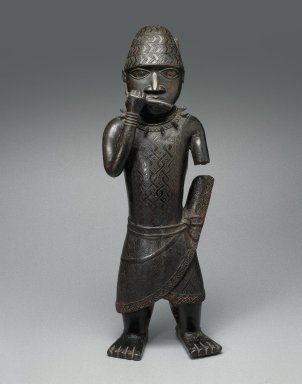“Africanizing” Wikipedia
As I’ve been leading the current Wikipedia initiative at the Brooklyn Museum, I have recently started working with our curator of African Art, Kevin Dumouchelle, to write and edit articles that relate to objects in our Arts of Africa collection. In my last post, I outlined our history working with WikiAfrica, a project designed to “Africanize” Wikipedia by contributing research, engaging relevant institutions, releasing publications, and hosting events.
In light of the dearth of good quality information on topics related to historical African art on Wikipedia, I met with Kevin to brainstorm ways to approach the task of using our assets to augment existing Wikipedia articles, and write new articles, on these topics. Kevin informed me that he was in the early stages of planning the reinstallation of African Innovations, slated for 2015, which will include focused galleries on individual African cultures.

Edo. Figure of a Hornblower, ca. 1500-1550. Copper alloy, 24 1/2 x 8 1/2 x 6 in. (62.2 x 21.6 x 15.2 cm). Brooklyn Museum, Gift of Mr. and Mrs. Alastair B. Martin, the Guennol Collection, 55.87. Creative Commons-BY
Image: front, 55.87_front_SL1.jpg. Brooklyn Museum photograph
I suggested that we use objects from our collection as starting points in thinking about new articles for creation, an approach that runs counter to the prevalent instinct in art historical writing to place the object at the forefront of the text. With this methodology, visual analysis of objects gives way to a deeper understanding of their context and the culture or individual who created them, but the opposite approach must be taken when writing for Wikipedia. In the context of an encyclopedia article, objects must serve to illustrate the text, rather than the other way around. Moreover, Wikipedia’s core policy of “Neutral Point of View” restricts us from interpreting objects in a novel way, or even giving a particularly nuanced description of an object. For example, a Wikipedia article on ancestral altars from Benin would offer context for an object in our collection, a figure of a hornblower that probably stood on such an altar. While contrary to the way we might approach the task of writing about our collections, we recognize that this approach is necessary in order to share objective information with a wider audience.
My first step was to assess the presence and quality of existing Wikipedia articles. An initial search revealed that there are huge gaps in information and the articles that do exist are often of poor quality and riddled with inaccuracies and language that perpetuates misleading stereotypes. Given the current state of affairs, my two main goals in editing existing articles on topics related to historical African art are 1) to add content from important and highly regarded source material and 2) to replace incorrect information and terminology.
As an example of this type of terminology, let’s consider the word “tribe” or “tribal.” Most scholars who study African states and societies agree that the term “tribe” has no consistent meaning: “It carries misleading historical and cultural assumptions. It blocks accurate views of African realities. At best, any interpretation of African events that relies on the idea of tribe contributes no understanding of specific issues in specific countries. It generalizes a continent’s worth of different social organizations―empires, kingdoms, city-states, autonomous villages, etc―into an overly broad and pejorative term. Indeed, it perpetuates the idea that African identities and conflicts are in some way more ‘primitive’ than those in other parts of the world.” And yet the word is used pervasively in Wikipedia articles on historical African art. If you do a Google search for “Wikipedia African Art,” the second thing to come up is the Wikipedia article on “Tribal Art”; the words “tribe” and “tribal” are used seven times (!) in the general article on African Art.
Three weeks later, I’ve written and edited nearly 20 articles related to the Benin and Yoruba culture groups. It is immensely satisfying to contribute this particular content to Wikipedia, particularly since it is both so rich and so poorly represented on the site.
Throughout the writing and editing process, I am always looking for places to seed our images, which were uploaded en masse to Wikimedia Commons. I did this either to pre-existing articles, to which I would add further research and relevant source material, or to new articles I created. It is exciting to finally make these incredible objects more widely available by inserting their images in a deserving context.
What makes this particular initiative unique is that it came from outside of the institution. When WikiAfrica approached us, it catalyzed an ongoing collaboration that falls directly in line with the Museum’s institutional mission to make our amazing collections available to the widest possible audience, including both visitors who walk through our doors and members of the worldwide community of people interested in art. We are grateful to WikiAfrica for having brought this fantastic project to our attention.

Alexandra Thom is coordinating a Kress-funded project at the Brooklyn Museum where she works to make scholarly and curatorial information about the Museum’s collections available to the public on Wikipedia. Prior to joining the Museum, Alexandra was the Curatorial Assistant at The Water Tank Project. She is also the co-founder of Archer&Leo, a Brooklyn-based creative agency, and a published author of short fiction. She earned her M.A. from The Courtauld Institute of Art and B.A. from Vassar College.
